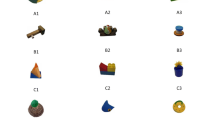Abstract
Nine verbally competent adult participants (three male and six female) were exposed to a stimulus equivalence training procedure. Using a matching-to-sample procedure they learned to match three haptically perceived stimuli (B1, B2, and B3) to three nonsense syllables (A1, A2, and A3), and three different nonsense syllables (C1, C2, and C3) to the haptically perceived stimuli. The haptically perceived stimuli were three different wooden blocks each weighing 500 g, attached to cylindrical wooden handles 31 cm long and 2 cm in diameter. Participants perceived these stimuli by wielding them in their right hands for 5 sees. Eight participants successfully completed training, of these seven demonstrated that they had formed equivalence classes by responding with greater than 80% accuracy on tests for four emergent relations: B-A symmetry, C-B symmetry, A-C transitivity, and C-A combined symmetry and transitivity. These findings provide an empirical demonstration of the formation of equivalence classes involving stimuli perceived via the human haptic system and extend the applicability of the equivalence approach.
Similar content being viewed by others
References
BARAC-CIKOZA, D., & TURVEY, M. T. (1991). Perceiving aperture size by striking. Journal of Experimental Psychology; Human Perception and Performance, 17, 330–346.
CHAN, T., & TURVEY, M. T. (1991). Perceiving the vertical distance of surfaces by means of a hand-held probe. Journal of Experimental Psychology: Human Perception and Performance, 17, 347–358.
DE GRANDPRE, R. J., BICKEL, W. K., & HIGGINS, H. S. (1992). Emergent equivalence relations between interoceptive (drug) and exeroceptive (visual) stimuli. Journal of the Experimental Analysis of Behavior, 58, 9–18.
DUGDALE, N., & LOWE, C. F. (1990). Naming and stimulus equivalence. In D. E. Blackman & H. Lejeune (Eds.), Behaviour analysis in theory and practice. London: Lawrence Erlbaum.
FIELDS, L., & NEVIN, J. A. (Eds.). (1993). Stimulus Equivalence (Special issue). The Psychological Record, 43 (Fall).
HAYES, L. J., TILLEY, K. J., & HAYES, S. C. (1988). Extending equivalence class membership to gustatory stimuli. The Psychological Record, 38, 473–482.
HAYES, S. C., DEVANY, J. M., KOHLENBERG, B. S., BROWNSTEIN, A. J., & SHELBY, J. (1987). Stimulus equivalence and the symbolic control of behaviour. Revist. Mexicana de Analisis de la Conducta, 13, 361–374.
HAYES, S. C., KOHLENBERG, B. S., & HAYES, L. J. (1991). The transfer of specific and general consequential functions through simple and conditional equivalence relations. Journal of the Experimental Analysis of Behavior, 56, 119–137.
SIDMAN, M. (1990). Equivalence relations: Where do they come from? In D. E. Blackman & H. Lejeune (Eds.), Behaviour analysis in theory and practice. London: Lawrence Erlbaum.
SOLOMON, H. Y., & TURVEY, M. T. (1988). Haptically perceiving the distances reachable with hand-held objects. Journal of Experimental Psychology: Human Perception and Performance, 14, 404–427.
TURVEY, M. T., SOLOMON, H. Y, & BURTON, G. (1989). An ecological analysis of knowing by wielding. Journal of the Experimental Analysis of Behavior, 52, 387–407.
Author information
Authors and Affiliations
Rights and permissions
About this article
Cite this article
Tierney, K.J., De Largy, P. & Bracken, M. Formation of an Equivalence Class Incorporating Haptic Stimuli. Psychol Rec 45, 431–437 (1995). https://doi.org/10.1007/BF03395152
Published:
Issue Date:
DOI: https://doi.org/10.1007/BF03395152




